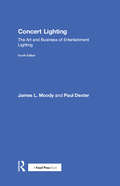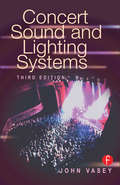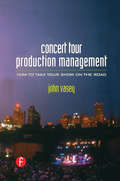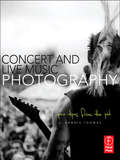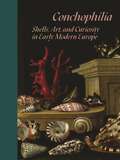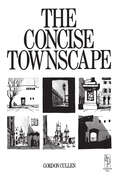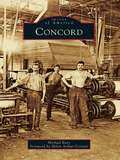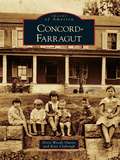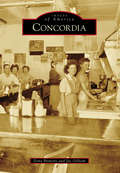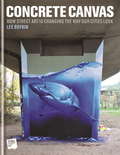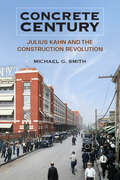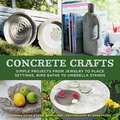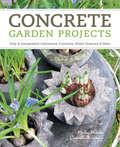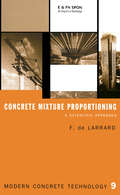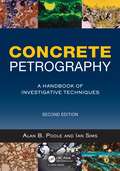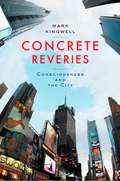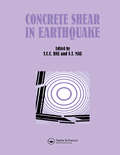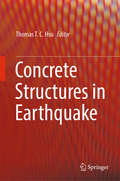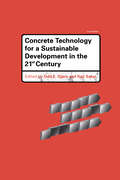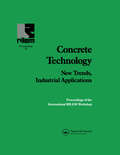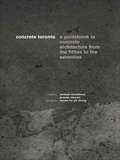- Table View
- List View
Concert Design: The Road, The Craft, The Industry
by Seth JacksonConcert Design: The Road, The Craft, The Industry offers an exceptional journey though the world of concert design, exploring not only its unique design attributes but also the industry that has grown around it and how to make a career of ‘the road’. Concert designer Seth Jackson analyzes how the industry has changed over the last three decades – from its early days of ‘no rules’ and ‘cowboys’ to a thriving and growing industry with countless career opportunities. Drawing on 25 years of experience and clients ranging from Carrie Underwood to Don Henley, he explores design techniques, working with Artists and directors, the rigors of concert touring, and navigating a career path through a challenging industry. The book also includes stories from numerous industry luminaries such as Steve Cohen, Jeff Ravitz, Eric Loader, Howard Ungerleider, and Jim Lenahan, along with Jackson’s own experiences. Written for aspiring concert lighting designers and students of Concert Lighting and Theatre Lighting courses, Concert Design is an excellent resource for anyone who has ever wondered what backstage life is really all about.
Concert Lighting: The Art and Business of Entertainment Lighting
by James Moody Paul DexterConcert Lighting: Tools, Techniques, Art, and Business Fourth Edition provides readers with an updated look at how to succeed in the complex world of concert lighting design and technology. The authors have reorganized the book into three comprehensive and thoroughly revised sections, covering history, equipment and technology, and design, and containing new information on LED technology, pixel mapping, projection options, media servers, automated lighting, solutions for moving lights, DMX, and Ethernet problems, and designer communication and collaboration. This book also explores the cross-media use of concert lighting techniques in film, video, theatre, and the corporate world, highlighted with advice from master designers such as Bruce Rodgers, Cosmo Wilson, and Sarah Landau. From securing precious contracts to knowing the best equipment to use to design a show, Concert Lighting covers everything a designer needs to know about working in the touring industry.
Concert Sound and Lighting Systems
by John VaseyConcert Sound and Lighting Systems provides comprehensive coverage of equipment and setup procedures for touring concert systems. The new edition will cover the new equipment now available and discuss other venues where the skills and technology are being used. This new edition incorporates the continuing developments in concert sound and lighting systems maintaining the premise that the reader has had no previous experience. The practical how-to illustrations teach the reader about the equipment, and this thoroughly updated edition will include new equipment such as radio microphones, in-ear monitoring, digital audio products and digital lighting products. The author also discusses new venues outside thetraditional concert touring environment and applies the skills and technology to such diverse events as product launches, theatrical arena spectaculars and outdoor stadium productions. In addition to an introductory section on touring concerts, there are sections on sound systems and lighting systems and an explanation of how all the parts fit together to create a professional, safe, efficient show.
Concert Tour Production Management
by John VaseyConcert Tour Production Management deals with the business of production and sets out guidelines to follow in order to literally get the show on the road. Concert Tour Production Management provides the basic information to manage the production for a touring concert from start to finish in the most effective and efficient way possible. Beginning with an introduction to the touring concert, explaining who's who on the road, the author guides you through a tour setup using a realistic itinerary that visits different types of venues using the production manager's checklists. He also covers the role of the local promoter's production manager and how to manage a crew. The appendices provide some basic electrical formulae, a performance contract, a technical rider, a production checklist to suit most situations, and several forms to help expedite routine tasks.
Concert and Live Music Photography: Pro Tips from the Pit
by J. Dennis ThomasIf you've ever wanted to take dynamic and vibrant digital photos of your favorite band in concert, but aren't sure how to tackle such obstacles as approaching the stage, tricky lighting situations, or even what equipment to use, then look no further! Concert and Live Music Photography is a comprehensive guide to shooting live music performances, providing you with the right information on equipment, camera settings, composition, and post-processing to get the best out of each performance shot. J. Dennis Thomas, whose work has appeared in such magazines as Rolling Stone, SPIN, and Country Weekly, shares tips on lighting, common problems, etiquette, and recommended camera settings for shooting in a variety of different venues, including clubs, bars, outdoor concerts, theatres, stadiums, and arenas. He also explains how to get the right credentials to get you closer to each performance. Jam packed with over 160 photos from today's top concerts, this book will not only give you the information you need to start taking rockin' photos of your favorite musicians, but will spark your creativity when you're anticipating the next shot. For the on-the-go photographer, a cool companion website features additional tips, venue troubleshooting, and an equipment checklist when you need to think on your feet while running to another gig.
Conchophilia: Shells, Art, and Curiosity in Early Modern Europe
by Hanneke Grootenboer Claudia Swan Anne Goldgar Marisa Anne BassA captivating historical look at the cultural and artistic significance of shells in early modern EuropeAmong nature’s most artful creations, shells have long inspired the curiosity and passion of artisans, artists, collectors, and thinkers. Conchophilia delves into the intimate relationship between shells and people, offering an unprecedented account of the early modern era, when the influx of exotic shells to Europe fueled their study and representation as never before. From elaborate nautilus cups and shell-encrusted grottoes to delicate miniatures, this richly illustrated book reveals how the love of shells intersected not only with the rise of natural history and global trade but also with philosophical inquiry, issues of race and gender, and the ascent of art-historical connoisseurship.Shells circulated at the nexus of commerce and intellectual pursuit, suggesting new ways of thinking about relationships between Europe and the rest of the world. The authors focus on northern Europe, where the interest and trade in shells had its greatest impact on the visual arts. They consider how shells were perceived as exotic objects, the role of shells in courtly collections, their place in still-life tableaus, and the connections between their forms and those of the human body. They examine how artists gilded, carved, etched, and inked shells to evoke the permeable boundary between art and nature. These interactions with shells shaped the ways that early modern individuals perceived their relation to the natural world, and their endeavors in art and the acquisition of knowledge.Spanning painting and print to architecture and the decorative arts, Conchophilia uncovers the fascinating ways that shells were circulated, depicted, collected, and valued during a time of remarkable global change.
Concise Townscape
by Gordon CullenThis book pioneered the concept of townscape. 'Townscape' is the art of giving visual coherence and organization to the jumble of buildings, streets and space that make up the urban environment. It has been a major influence on architects, planners and others concerned with what cities should look like.
Concord
by Helen Arthur-Cornett Michael EuryWhen state legislator Stephen Cabarrus sought a compromise between quarreling Scotch-Irish and German settlers over the location of Cabarrus County's seat, his appeal led to a "concord" that gave birth to one of North Carolina's most charming cities. Not long after its 1796 founding, Concord began a transformation from an agricultural community into a textile-manufacturing mecca as captains of industry built empires exploiting the cotton that so abundantly sprouted from the region's fruitful soil. By the advent of the 1900s, textiles' prosperity encouraged an architectural renaissance within Concord's downtown, where the stately buildings, churches, and residences still stand today. While the cotton mills that made Concord famous are no more, the city has transitioned into a fast-paced motorsports center and the home of North Carolina's most popular tourist destination, Concord Mills shopping mall.
Concord-Farragut
by Doris Woods OwensIn 1787, before Concord or Farragut existed, the area was known as Campbell's Station. The settlement grew rapidly, and by 1840, it was a thriving, self-sufficient community with many businesses. In the mid-1850s, the town of Concord was established two miles south of Campbell's Station along the newly installed railroad lines, drawing many businesses from Campbell's Station. Concord prospered, but Campbell's Station remained peaceful farmland. In 1902, Farragut High School was built in Campbell's Station. The school and the post office were the glue that held the west Knox County communities together. By 1944, nearly one-third of Concord was displaced by the impoundment of Fort Loudoun Lake. Soon Campbell's Station's sprawling farms became subdivisions, and Concord's businesses, churches, and even the post office were forced to relocate to Campbell's Station, leaving Concord a sleepy village. In 1980, a large area around the school but excluding Concord was incorporated as the town of Farragut.
Concordia
by Joe Gilliam Dena BisnetteIn 1869, Concordia, Kansas, was declared the county seat of what would become Cloud County. At first, the town existed only on paper as a project being pushed by James M. Hagaman and a small group of partners. Once development started, Concordia rapidly grew to become a center of commerce south of the Republican River that eventually attracted four railroad lines. It became a town of landmarks, including several famous hotels, two opera houses, Nazareth Convent, and a thriving downtown area. Characters in the story of Concordia include French Canadian immigrants, nuns, pilots, quarreling newspaper editors, German prisoners of war, and politician Frank Carlson. Readers can enjoy visiting the community's past in the pages of Images of America: Concordia.
Concrete Canvas: How Street Art Is Changing the Way Our Cities Look
by Dr Lee BofkinWhat happens when you look at graffiti and street art as unlimited art forms instead of urban phenomena? Concrete Canvas does just that; investigating the media the artists work with, the canvases they work on, the themes that arise through their work, and the way their art redefines the spaces in which it is set.Concrete Canvas is filled with stunning photos of works from new and exciting artists, as well as established names, including Ron English, Phlegm, Daim, Invader and more. It examines how the curation of public space is affecting our cities and moving art into the future. Global Street Art is the largest online archive of street art photography. Here, its founder Lee Bofkin shares some of his best stories of documenting street art, which variously feature big guns, massive dogs and lots of abandoned buildings.
Concrete Century: Julius Kahn and the Construction Revolution
by Michael G SmithAt the turn of the 20th century, industrial manufacturing was expanding dramatically while factory buildings remained fire-prone relics of an earlier age. That is, until a 28-year-old civil engineer finally achieved what engineers around the world had unsuccessfully attempted. Working in his brother’s basement in Detroit, Julius Kahn invented the first practical and scientific method of reinforcing concrete with steel bars, which finally made it possible to construct strong, fireproof buildings. After Kahn founded a company in 1903 to manufacture and sell his reinforcement bars, his system of construction became the most widely used throughout the world. Drawing upon Kahn’s personal correspondence, architectural drawings, company records, and contemporary news and journal articles, Michael G. Smith reveals how this man—whose family had immigrated to the US to escape antisemitism in Germany—played an important role in the rise of concrete. Concrete not only turned the tide against widespread destruction of buildings by fire, it also paved the way for our modern economy. Concrete Century will delight readers intrigued by architecture and construction technology alike with the true origin story of modern concrete buildings.
Concrete Crafts: Simple Projects from Jewelry to Place Settings, Birdbaths to Umbrella Stands
by Sania Hedengren Susanna Zacke Anna SkoogPouring concrete doesn't have to be left to the professionals-decorate your home with concrete poured, mixed, and molded by your own two hands! Versatile, inexpensive, and easily casted, concrete is the perfect medium for crafters, tinkerers, and home improvers. Now, lifelong crafters and interior designers Susanna Zacke and Sania Hedengren reveal more than thirty of their favorite, no-fuss casting projects.Decorate your kitchen table or outdoor patio with: Rhubarb leaf fruit bowls Clustered candleholders Birdbaths Patterned pots Flower vases Angel figurines And much more!Once you get started, you won't want to stop making trinkets and ornate arrangements for friends, family, and each room in your house. Plus, crafting with concrete is a great way to get outside and enjoy a beautiful, sunny day.Featuring step-by-step photos, easy-to-follow directions, and Susanna and Sania's expert tips, Concrete, the Perfect Hobby is the ultimate new guide to outdoor crafting. Pour out your creativity and discover the beautiful, practical items you can cast!
Concrete Design (Architect's Guidebooks to Structures)
by Paul W. McMullin Jonathan S. Price Esra Hasanbas PersellinConcrete Design covers concrete design fundamentals for architects and engineers, such as tension, flexural, shear, and compression elements, anchorage, lateral design, and footings. As part of the Architect’s Guidebooks to Structures Series it provides a comprehensive overview using both imperial and metric units of measurement. Written by experienced professional structural engineers Concrete Design is beautifully illustrated, with more than 170 black and white images, contains clear examples that show all design steps, and provides rules of thumb and simple tables for initial sizing. A refreshing change in textbooks for architectural materials courses, it is an indispensable reference for practicing architects and students alike. As a compact summary of key ideas it is ideal for anyone needing a quick guide to concrete design.
Concrete Garden Projects: Easy & Inexpensive Containers, Furniture, Water Features & More
by Camilla Arvidsson Malin NilssonFor gardeners and backyard do-it-yourselfers, concrete is a revelation. It's durable, weatherproof, impossible to steal, and it provides much-needed insulation for outdoor plants. Concrete weathers beautifully, softening around the edges, developing moss, and becoming more picturesque with age.Concrete Garden Projects takes advantage of concrete's numerous assets, showcasing an inspiring array of creative options. The step-by-step instructions for dozens of easy, do-it-yourself décor ideas include containers of all shapes and sizes, elegant benches and stools, miniature ponds and birdbaths, stepping stones, a barbecue, and a fire pit. The authors use a variety of molds easily found or made, household items like bowls and baking pans, and simple wooden frames and boxes. At pennies per pound, and so simple to use—just mix with water and pour—concrete is the key to hand-crafted backyard décor.
Concrete Mixture Proportioning: A Scientific Approach (Modern Concrete Technology)
by Francois De LarrardThe design of concrete mixes is becoming increasingly complex, with the addition of new materials in the compounds, such as organic admixtures, fibres and supplementary cementitious materials. Moreover, the list of properties which concretes are required to possess for certain applications has increased, and interest is developing in rheology, dura
Concrete Petrography: A Handbook of Investigative Techniques, Second Edition
by ALAN B. POOLE; IAN SIMSThis classic reference has established the value of petrography as a powerful method for the investigation of concrete as a material. It provides an authoritative and well-illustrated review of concrete composition and textures, including the causes of defects, deterioration, and failure that can be identified using a petrological microscope. This new edition is entirely revised and updated and also greatly extended to take account of new scientific developments and significant improvements in instrumentation and to reflect current laboratory working practices, as well as to reflect new understanding of the performance of concrete and related materials. Now in full color throughout, Concrete Petrography, Second Edition provides case study examples, with appropriate explanatory discussions and practical advice on selecting, handling and preparing specimens. It assists and guides the engineer, the trainee and the experienced petrographer in understanding the scientific evidence that is basic to petrographic analysis and so will lead to more accurate and timely diagnosis and treatment of problems in structural concrete. This book includes: Contributions in specialist areas by internationally recognized experts Explanation of computer techniques as an aid to petrography Full coverage of inspection, sampling, and specimen preparation New sections covering recent technological development of equipment Guidance on observation of cement and concrete mineralogy and microfabrics Discussion and illustrative examples of deterioration and failure mechanisms New work and guidance on the determination of water/cement ratio New color illustrations and micrographs throughout Thorough updating of standards, other authoritative publications, and references A fully revised, extended, and updated glossary of optical and other properties
Concrete Reveries: Consciousness and the City
by Mark KingwellAn exploration of urbanism, personal identity, and how the space we live in shapes us<P> According to philosopher and cultural critic Mark Kingwell, the transnational global city—New York and Shanghai—is the most significant machine our species has ever produced. And yet, he says, we fail again and again to understand it. How do cities shape us, and how do we shape them? That is the subject of Concrete Reveries, which investigates how we occupy city space and why place is so important to who we are.<P> Kingwell explores the sights, smells, and forms of the city, reflecting on how they mold our notions of identity, the limits of social and political engagement, and our moral obligations as citizens. He offers a critique of the monumental architectural supermodernism in which buildings are valued more for their exteriors than for what is inside, as well as some lively writing on the significance of threshold structures like doorways, lobbies, and porches and the kinds of emotional attachments we form to ballparks, carnival grounds, and gardens. In the process, he gives us a whole new set of models and metaphors for thinking about the city.
Concrete Shear in Earthquake
by S. T. Mau T. C. C. HsuThis volume consists of papers presented at the International Workshop on Concrete Shear in Earthquake, held at the University of Houston, Texas, USA, 13-16 January 1991.
Concrete Slabs: Analysis and design
by L.A. Clarke R J Cope R.J. CopeAlthough the beginning of man's ability to predict the behaviour of slabs dates from the Napoleonic era, analysis and design of reinforced concrete slabs are still active areas of research. Reinforced concrete slabs were first built on a regular basis at the start of the twentieth century, while prestressing has become popular during the last twenty years. Despite the enormous experience gained in this time, there is still no general agreement on the best design procedures. In this text the basic equations governing slab behaviour are clearly explained. Methods of solution in use before the advent of computers are briefly described and illustrated. Numerical procedures capable of solving slabs of almost any geometry are then described in detail, and computer programs are provided for use. To enable these methods to be used for approximate analyses of common forms of pseudo-slab construction, recommendations on the necessary structural idealisations are provided.
Concrete Structures in Earthquake
by Thomas T. C. HsuThis book gathers 23 papers by top experts from 11 countries, presented at the 3rd Houston International Forum: Concrete Structures in Earthquake. Designing infrastructures to resist earthquakes has always been the focus and mission of scientists and engineers located in tectonically active regions, especially around the “Pacific Rim of Fire” including China, Japan, and the USA. The pace of research and innovation has accelerated in the past three decades, reflecting the need to mitigate the risk of severe damage to interconnected infrastructures, and to facilitate the incorporation of high-speed computers and the internet. The respective papers focus on the design and analysis of concrete structures subjected to earthquakes, advance the state of knowledge in disaster mitigation, and address the safety of infrastructures in general.
Concrete Technology for a Sustainable Development in the 21st Century
by Koji Sakai Odd E. Gj0rvConcrete technology for a sustainable development in the 21st century focuses on the problems and challenges for the concrete industry today and in the future with particular emphasis on environmental consiousness. Primary topics include: the improvement of concretes service life to ease technical and economical problems and the waste of natural re
Concrete Technology: Proceedings of the International RILEM workshop
by Antonio Aguado Ravindra GettuThis book forms the Proceedings of an RILEM workshop in Barcelona in November 1994. It is structured as a series of presentations/reviews by some of the leading international researchers and technical experts of the concrete world. Coverage ranges from developments in materials science, through performance and behaviour of concrete, to manufacturin
Concrete Toronto: A Guide to Concrete Architecture from the Fifties to the Seventies
by Michael Mcclelland Graeme StewartAfter World War II, concrete became increasingly popular as a building medium around the world. Brutalism, the fashion for plain, heavy design, reigned. Toronto was particularly affected. The city has concrete buildings of all stripes international landmarks, metropolitan infrastructure and even the single family home. Hundreds of these structures were built, including Viljo Revells groundbreaking New City Hall, John Andrews seminal Scarborough College and the record-smashing CN Tower. Toronto is a city cast in concrete. However, as architectural fashion has shifted from postmodernism to the glass-and-steel neomodernism of today, these concrete structures have been ignored, misunderstood and, in some cases, demolished. Concrete Toronto acts as a guide to the city's extensive concrete heritage. A diverse group of experts has been assembled to re-examine the uniqueness and value of these buildings. Included are the insights of many of the original concrete architects, university faculty, local practitioners, journalists and industry experts. Together they explore the past and future of Toronto's concrete buildings. Included is a wealth of new and archival photos, drawings, interviews, articles, as well as case studies of Toronto's major concrete architecture.
Concrete and Clay: Reworking Nature in New York City (Urban and Industrial Environments)
by Matthew GandyAn interdisciplinary account of the environmental history and changing landscape of New York City. In this innovative account of the urbanization of nature in New York City, Matthew Gandy explores how the raw materials of nature have been reworked to produce a "metropolitan nature" distinct from the forms of nature experienced by early settlers. The book traces five broad developments: the expansion and redefinition of public space, the construction of landscaped highways, the creation of a modern water supply system, the radical environmental politics of the barrio in the late 1960s and early 1970s, and the contemporary politics of the environmental justice movement. Drawing on political economy, environmental studies, social theory, cultural theory, and architecture, Gandy shows how New York's environmental history is bound up not only with the upstate landscapes that stretch beyond the city's political boundaries but also with more distant places that reflect the nation's colonial and imperial legacies. Using the shifting meaning of nature under urbanization as a framework, he looks at how modern nature has been produced through interrelated transformations ranging from new water technologies to changing fashions in landscape design. Throughout, he considers the economic and ideological forces that underlie phenomena as diverse as the location of parks and the social stigma of dirty neighborhoods.

